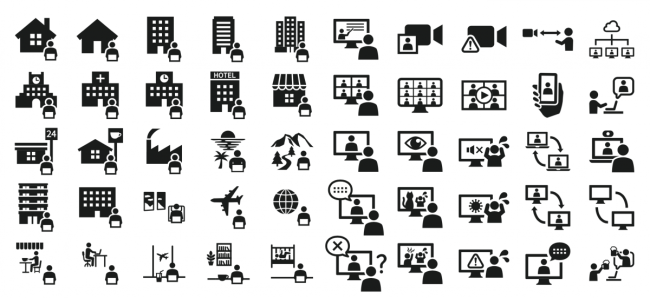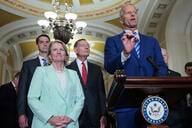You have /5 articles left.
Sign up for a free account or log in.

iStock/Getty Images Plus/YS
Academic conference formats seen during the pandemic “were born of necessity” but “aligned to pressures that had been building for years,” according to a new research report from Ithaka S+R. And while COVID-19 still makes the look and feel of future conferences hard to predict, it’s clear to Ithaka that even after the pandemic, scholarly meetings are “unlikely to simply return to the old status quo.”
Ithaka’s report announces the creation of a cohort of scholarly societies that will explore and help shape the scholarly meeting's future, through traditional, hybrid and fully online modes. The cohort, which will be co-organized by JSTOR Labs and funded by the Alfred P. Sloan Foundation, will engage in research, collaboration and design thinking to address the various challenges associations face in long-term planning for multimodal conferences.
While that effort is just beginning, Ithaka’s report offers insight into how associations planned for and executed conferences from March 2020 to last month. This preliminary research was guided by three questions, concerning 13 major professional associations:
- How have societies adapted their annual meetings in the face of the pandemic?
- What lessons about the future of annual meetings can we learn from their experiences doing so?
- What questions and topics should guide future research aimed at supporting these important forms of scholarly communication?
‘Cancellations’
In the time period studied, the 13 societies had 19 annual meetings scheduled. Of those, six were canceled. Most of these happened in spring and summer of 2020. The report notes that “cancellation” is a complicated term, however, in that just two meetings were canceled outright, while four were replaced by some kind of virtual program. The American Historical Association, for instance, canceled its early 2021 meeting and replaced it with what it described as a “yearlong platform of online opportunities to bring together communities of historians.” The American Sociological Association canceled its 2020 and 20201 meetings, replacing both with virtual gatherings.
Ithaka attributes this complicated nomenclature, in part, to possible legal concerns surrounding the use of force majeure clauses in associations’ contracts with meeting vendors. That is, terminating an event may be linked to the need to terminate a hotel or conference site contract, according to the report. In any case, Ithaka urges more transparency and streamlining of language regarding this hidden side of annual meetings.
“One laudable effect of the pandemic is that societies are beginning to communicate the financial costs of meetings to members as part of their communication around plans to proceed with or cancel in-person meetings,” the report says. It notes that the American Academy of Religion, for instance, told its members this year that mounting a fully hybrid annual meeting would add $4.3 million to its conference expenses (it opted instead for an in-person meeting, with a limited number of virtual sessions). After all, Ithaka’s report continues, there are “significant costs associated with shifts in modality." Such challenges will feature prominently in the upcoming Ithaka and JSTOR Labs project.
Platforms, Registration and Attendance
Regarding the platforms associations used to deliver their virtual meetings, most used Zoom for at least some sessions. This is in line with prior Ithaka research finding heavy reliance on “basic webinar platforms” for virtual conferences. Other vendors used included Confex, EventScribe Live, Facebook Live, BAV Systems and EventPilot (which has integrated with Zoom). YouTube and program apps’ embedding features were used to archive content after the fact in many cases. Ithaka found little evidence of gamification in pandemic-era meetings.
Most societies charged sliding-scale rates for virtual meetings, with regular member rates ranging from $99 to $325. Five societies specifically mentioned that they had reduced registration rates for their virtual meetings relative to the previous year, according to the report. Ithaka wasn’t able to determine a clear discount rate, though some associations’ discounts appeared to be as much as 50 percent. The historians’ virtual programs were offered free of charge.
Ithaka's report says it can only “speculate as to why some societies reduced their registration rates for virtual annual meetings,” though some “may have used discounts as a way of encouraging attendance at events which did not have proven audiences, or as an implicit acknowledgement that the perceived value of the experience had been diminished by the change in format.”
Attendance numbers for virtual meetings are particularly meaningful, according to the report, but Ithaka was unable to paint a full picture of pandemic-era meeting attendance. The attendance data it did collect suggest that humanities scholars may have been more receptive to online meetings than those in the natural sciences, technology, math and engineering. Public information regarding the Modern Language Association suggests registration numbers roughly in line with attendance at other recent conventions, for instance, while the fall 2020 meeting of the American Chemical Society was about half as big as in the years prior.
On attendance, Ithaka says it will be important going forward to gather data not just on how many scholars are attending meetings, but who those scholars are.
“Given the prevalence of the idea that virtual meetings are more accessible to early-career professionals, caregivers and others who for financial, health, or other reasons find in-person participation at annual meetings difficult, it would be useful to know if the demographic composition and geographic distribution of attendees shifted along with the change to virtual formats,” the report says. “Likewise, many societies would likely want to know whether conference regulars continued to engage.” The MLA, for instance, reported that graduate students were unusually well represented at the 2021 virtual convention.
On the AHA’s yearlong program, Ithaka’s report says that the “decision to demonetize its conference has been wildly successful: between its launch in summer 2020 and December, over 16,000 people had attended sessions or viewed recordings of them, a huge number for a society which has attracted roughly a third of that number to recent in-person annual meetings.”
The More Things Change
In terms of virtual content, Ithaka found that societies generally reproduced most elements of their in-person meetings, namely through research-oriented sessions, social and networking events, professional development activities, governance meetings, and even exhibit halls (this particular area may need developing for the virtual and hybrid space, according to Ithaka).
One notable exception to this translation of “normal” meeting activities to online is the Native American and Indigenous Studies Association, which did not accept research panels for its 2021 virtual meeting, as it "judged them poorly suited to the conversational, relationship based, and dialogic virtual environment they hope to support and towards which the discipline is oriented,” according to Ithaka. Instead, the group had two other types of formats: roundtable discussions and creative works.
Over all, Ithaka found the "significant continuities with in-person meetings" to be “reasonable enough,” given that the pivot to virtual engagements “required considerable creativity and labor from society staff, and the stresses of doing so on short notice during a global pandemic encouraged ‘good enough’ planning in ways that will be familiar to instructors who made abrupt adaptations to online teaching.”
Yet under this surface, Ithaka did find two areas of significant innovation: lengthening of conference schedules -- in some cases well beyond the standard long-weekend format -- and experimentation with recorded content alongside or in place of live events.
“Both practices have the potential to significantly change the familiar temporal experience of conferences as dense and clearly-bounded events to something more elastic and less-differentiated -- spatially and temporally -- from everyday life,” the report says. “They also raise questions about whether we may see conferences morph into something that more closely resembles a content stream, a trend that seems emergent.”
The Association for Asian Studies, for example, added a few days to its original in-person schedule, while the chemical society met across the month of April this year. This trend is apparent in upcoming hybrid meetings as well, according to Ithaka, with the joint meeting of religion scholars and the Society for Biblical Literature happening from Nov. 29 to Dec. 10.
The MLA and the College Art Association, meanwhile, have kept to three- or four-day schedules, but also made recordings of sessions available to registrants for extended periods of time after the meetings.
“Clearly,” Ithaka’s report says, “the opportunity to easily expand a conference schedule is one of the immediate advantages that the virtual meetings of 2020-21 afforded,” as extending schedules reduced Zoom fatigue. Even more importantly, the report says, extended schedules allowed organizers to reduce the need for concurrent panels and to concentrate programs in “prime slots” (no more 8 a.m. sessions), even across multiple time zones, allowing for greater participation. Making sessions available on demand was an extension of this, offering attendees further flexibility.
Looking Ahead
Both these innovations “unquestionably increase the accessibility of conference programming and have the potential to greatly increase their audiences,” the report says. Yet they raise important questions, as far as Ithaka is concerned, including how academics value the conference as a discrete event. In other words, the report asks, “How far can a meeting be stretched before its identity becomes diluted beyond recognition?” More than that, the report asks, “What are the implications of thinking about professional societies -- which in many cases are oriented towards service to a discipline -- as content providers and media organizations?”
In the near-term future, eight of the 13 societies included in Ithaka’s report are planning late 2021 and early 2022 conferences as hybrid events. Four are planning explicitly in-person events, at least one of which will have limited virtual programs. And it seems “quite possible that the in-person meetings may yet be forced to adopt some hybrid programming,” according to Ithaka. Just one group, the American Society of Civil Engineers, has planned a fully virtual meeting.
All this suggests the possibility that the future will include “what are essentially parallel, rather than truly hybrid conferences, with smaller in-person meetings supplemented by distinct virtual ones with minimal access to live activities for virtual registrants,” the report says. And this creates the "troubling" potential for such meetings to “exacerbate already pronounced inequalities of access to annual meetings."
Even so, the relative successes of virtual meetings have demonstrated that there is a "constituency for virtual events, and perhaps an expectation of them among the members of scholarly societies," according to Ithaka. And the pandemic has provided “a largely, if not unilaterally, positive test of their viability.”
Different organizations will find different paths forward, the report says, yet all conversations about the future of conferences should involve the following points:
- Virtual programming will be an important part of the mission of scholarly societies in the future.
- In-person meetings will not disappear overnight.
- Regardless of format, organizing annual conferences is labor- and capital-intensive.
- Absent careful planning, new conference models may perpetuate structural inequalities and hierarchies of access.
- Changes in modality provide opportunities for the emergence of new genres of scholarly communication.
The Ithaka study was written by Dylan Ruediger, an Ithaka analyst, and Danielle Cooper, associate director of libraries, scholarly communications and museums at Ithaka.
Ruediger said this week that many scholars have become accustomed to virtual meetings during COVID-19, and that travel funding, “something that early career, contingently employed and others already struggled with prior to the pandemic, will be an even larger barrier to in-person participation going forward.”
Numerous scholarly associations told Inside Higher Ed earlier this year that while they were planning conferences with hybrid elements going forward, fully hybrid conferences were a long way off. That’s due to the fact that members miss the in-person conference experience, as well as the prohibitive technology cost of live-streaming all panels from a conference site, these associations said.
Ruediger said he and Cooper also found that virtual conference models haven't yet "replicated the networking and social experiences" of in-person conferences, and that "viable financial and technological models for fully hybrid meetings don’t currently exist.”
“These are major challenges that societies must navigate,” he added.
As of now, it's clear that the future will include "multiple modalities of meetings, including virtual, in-person and hybrid events,” Ruediger said. That’s something that the new cohort project will explore, he continued, by providing societies "a forum for developing meeting strategies that take advantage of the opportunities different formats provide for scholarly communication and allow for more equitable access to their member communities.”
The ‘Will and the Time’
Futurist Bryan Alexander said he was struck by several of Ithaka’s findings, including the historical association's plan to offer a long-term virtual program, in addition to a mainly in-person annual meeting. Borrowing Howard Rheingold’s term, Alexander said this sounded like virtual communities. Alexander also said he wondered if a “border” might need to be drawn between yearlong programs and the extended online events some associations are planning (the AHA plans to return to an in-person format in early 2022).
Alexander’s other observations: that academics appeared to reject gamelike platforms; that reduced fees for virtual events reflect a “general economic sense that digital means free or lower cost” and the lack of a face-to-face experience; and that hybridity, or “HyFlex,” in pedagogical lingo, might be the “new baseline for events, given the many reasons people have for remote participation.”
Two topics Alexander felt were missing from the report were discussions of social media, and how many academics’ familiarity with it facilitated the shift to online and hybrid, along with the environmental implications of in-person conferences.
“Reducing greenhouse gas emissions is something academics have been slow to realize but may be starting to think and plan around,” Alexander said.
Amy J. Ko, professor at the University of Washington at Seattle’s Information School (who is cited in the new Ithaka report), has written multiple essays about conferences during and after COVID-19. Those include a hybrid conference “wish list” and a reflection on a virtual conference that she co-chaired.
Summing up some of her experiences Tuesday, Ko said that “reinventing how we meet is not a simple one- or two-year process. We’re only at the beginning of experimenting, and most are only beginning to realize the complexity of creating vibrant, serendipitous social spaces, whether virtual or hybrid.”
Beyond matters of meeting format, Ko said, “The question is whether our communities will commit to those experiments, not just to see them through, but to achieve greater goals of equity, inclusion and sustainability.”
Ko said she’s “confident that if we bring together the world’s experts on computer-mediated communication, online communities and human connection that we could find superior forms of hybrid academic networking.” She’s “less confident,” however, “that we have the will or time to reinvent, as our communities are largely run by overcommitted volunteers.”





